How To Manage the Persistent-Slab Avalanche Problem
In my home state of Colorado, our winter snowpack tends to develop a dangerous type of hazard, the persistent slab avalanche. Persistent slab avalanches account for the vast majority of avalanche fatalities in the state. Persistent slabs are aptly named—days or even weeks after a storm event, when the danger seems to have passed, you can still trigger one of these avalanches. The problem demands a heightened awareness and a thoughtful approach to terrain selection and risk management. This article explores strategies and tactics you can use to help manage your risk when dealing with this challenging avalanche problem.
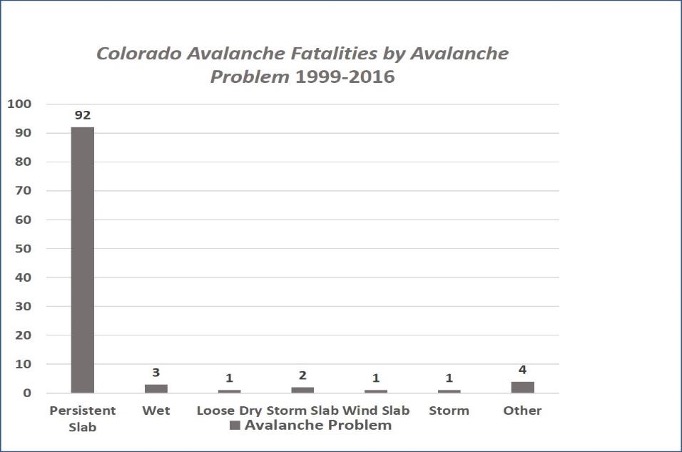
The term “persistent slab” refers to a cohesive slab that has formed above a persistent weak layer: facets, depth hoar, or surface hoar. Although these conditions are most common in interior ranges with a continental snowpack like Colorado, you can find the persistent slab avalanche problem in all snowpacks and mountain ranges. Avalanche experts consider persistent slab avalanches to be the most dangerous and unpredictable type of avalanche. There are several reasons why:
- Persistent weak layers can resist strengthening and remain reactive to triggers for weeks or even months. Avalanches formed by storm snow and wind are short-lived problems that cause a spike in hazard, then a rapid drop-off in danger. After a few days, avalanche danger decreases as the slabs bond with the underlying snowpack. With persistent slabs, the problem remains even as the danger rating drops over time. As the slab strengthens and the persistent weak layer is buried deeper in the snowpack, avalanches become harder to trigger but no less dangerous. You may be able to trigger an avalanche in areas of shallower snow, where the weak layer is easily impacted, and release adjacent, deeper areas, resulting in a large and destructive avalanche.
- Persistent weak layers can be widespread across the slope. They form avalanches that propagate long distances and break in unpredictable ways. They can cross multiple terrain features and aspects.
- Persistent slabs can be triggered from adjacent terrain. Another factor contributing to the unpredictability of persistent slabs is that they can be remotely triggered from outside the start zone. You can trigger these avalanches from above or to the side of the slope or from adjacent lower-angled but locally connected terrain. Unstable slabs have also been triggered from well below the start zone and even from flat ground.
- Most of the time, there are few visible clues on the snow surface to tell us where the persistent slab problem exists. Hazards created by falling or drifting snow, warming (sun or rain), or cornice failures all have visible clues recognizable by the backcountry tourer. The persistent slab avalanche problem provides few surface clues. Sometimes the weight of a rider can collapse the weak layer, and you may hear an audible whumph and see shooting cracks on the snow surface. These are compelling signs, and a warning of local instability. Otherwise, determining the distribution of a weak layer requires digging snow profiles, conducting snowpack tests, and investigating avalanches. This requires the skill and experience to conduct these observations safely. You must choose a representative observation site, identify grain types and layering, and interpret snowpack test results. For most recreationists, this means relying on the avalanche bulletin to help us identify and avoid terrain with the problem layer.
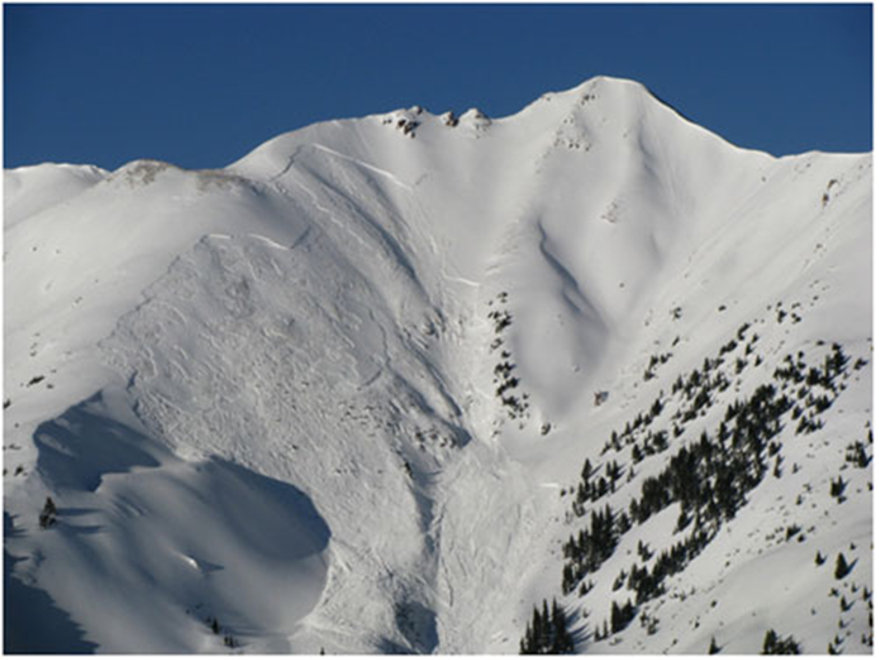
Managing the persistent slab avalanche problem starts during tour planning. Know the problem exists and plan to avoid it. First, look at the forecast and determine the aspects and elevations likely to have the problem. Persistent weak layers are formed by big-picture weather trends and are often distributed widely across the terrain. The persistent slab problem demands we think about the terrain on a large scale. If the problem exists on north and northeast aspects, for example, ruling out any slopes on the north-facing side of the drainage is a sensible approach.
But it is not always that simple. For example, in the photo below, the areas numbered 1 are north-northeast aspects. No. 2 is a south aspect. But what about No. 3? Technically, this is a southeast aspect. If the problem is isolated to north and northeast aspects, is this slope likely to have the problem as well? Quite possibly, yes. This slope is on the north side of the drainage, and despite its southerly tilt, it is shaded by nearby slopes most of the day. Its snowpack is probably more similar to that on the nearby surrounding terrain than to slopes on the south side of the drainage.
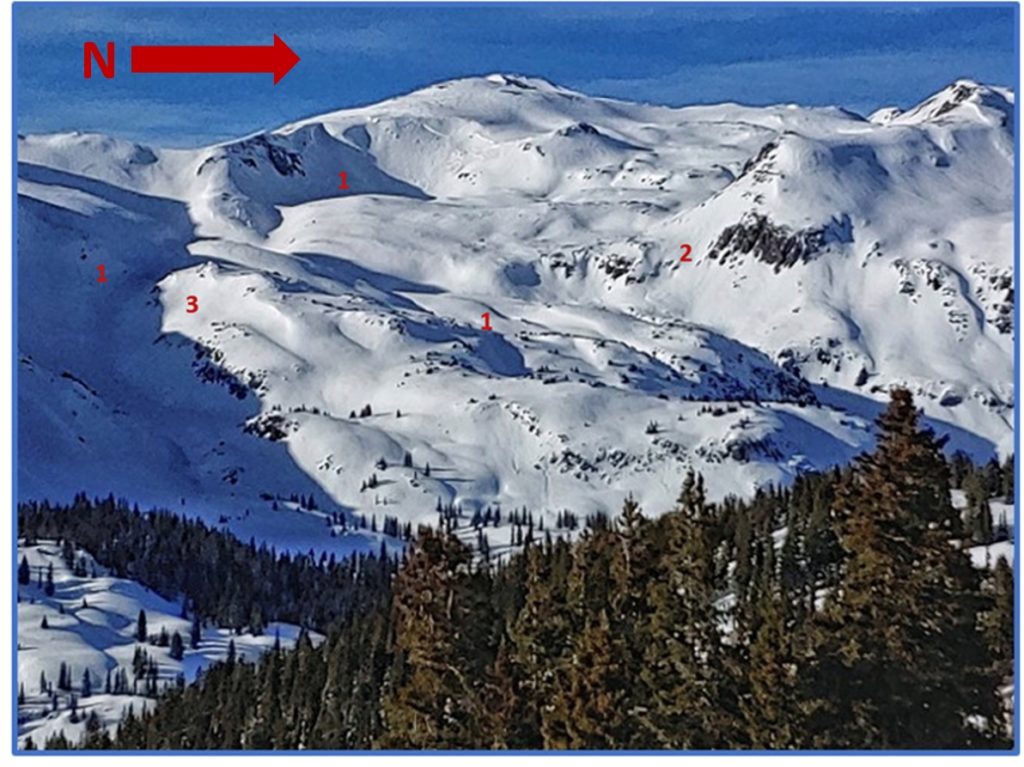
Sticking to lower-angled terrain is the best way to avoid any avalanche problem, but with a persistent slab problem, we need to pay attention to more than just the terrain we are riding. We have to take into account the terrain surrounding us. Is it connected to, or underneath one of the suspect aspects? Could we remotely trigger a slope that would overrun us? Slope No. 3, for example, is connected to and partially below steep, north-facing terrain, and both slopes run into a terrain trap. Consider your route carefully. Use maps and terrain imagery to help plan a safer tour. Give yourself a wide margin of safety from suspect terrain.
Planning your tour with an eye toward big-picture terrain and snowpack considerations is the first step in managing the persistent slab avalanche problem, but it doesn’t stop there. Slope-scale terrain and route selection, group management, and even mindset and expectations are all key pieces. Here are some specific measures we can take to help manage our risk in the field.
- Avoid trigger points. A common characteristic of persistent slab structure is a firm slab overlying a softer, weaker layer of snow. Avalanches can be triggered from areas where the firm slab above the weak layer is thinner. The snowpack offers few clues to where we may find a potential trigger point, but the terrain may offer some. Mid-slope features like knobs, ridges, and convexities are common places to find a trigger point. Winds tend to scour these features, creating thin areas in the slab. Rocks or vegetation protruding through the snowpack is another clue that you may be looking at a shallow slab covering the weak layer. The slab avalanche in the image below was triggered from the circled area, a thin spot on a slope-parallel sub-ridge in the middle of this bowl. The following photo is the same slope. You can see the shallow snow at the trigger point. Many ski tracks are visible in the image. As many as 15 people skied over the thicker part of this slab without incident before someone finally crossed the trigger point.
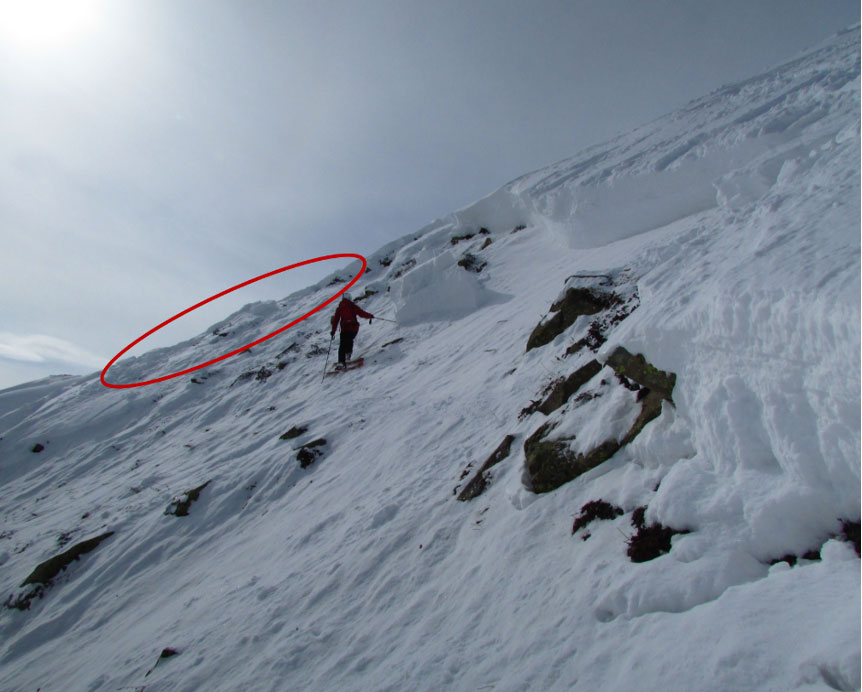
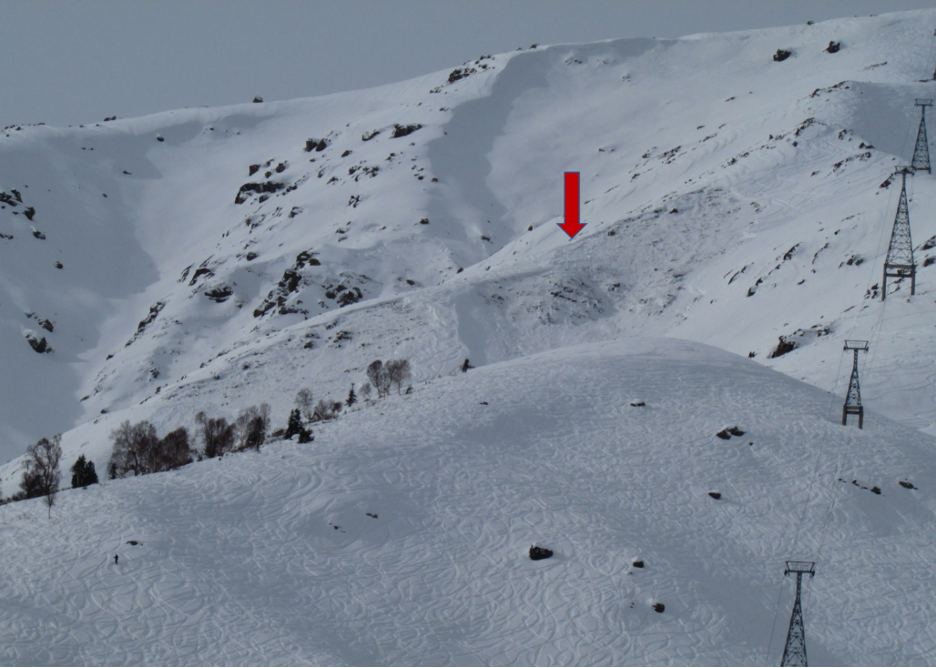
- Choose safe zones with care. The same concepts apply when choosing safe zones to spot your partner or regroup. Mid-slope ridges and knobs can give us a false sense of security. Instead, these features should be treated as potential trigger points and avoided. Similarly, lower-angled terrain within larger terrain features may be vulnerable to being overrun by a large avalanche. Accident records are littered with incidents where groups used mid-slope features or low-angle terrain below or adjacent to dangerous slopes as safe zones, only to have them overrun by an avalanche that they triggered. Many accidents with multiple victims are persistent slab avalanches, which is a common theme. Choose safe zones far from and not connected to any suspect slopes. In practice, this can be difficult and lead to a situation where you are farther from your partner than you would like to be, however this option is better than both of you being caught in an avalanche.
- Avoid complex terrain. Slope-scale terrain selection is critical to managing the persistent slab problem. Terrain with many different aspects and slope-angles, lots of small-scale terrain features and potential trigger points, terrain traps, or exposure to avalanche paths is difficult to navigate safely. Choose simpler terrain where it is easy to know what aspect you are on; where slope angles are moderate, consistent, and easy to measure; and where there are few potential trigger points and no terrain traps. Maps can be a helpful tool, but smaller features like trigger points, terrain traps and the overall terrain character are hard to identify with a map alone. Physical reconnaissance, photos, and satellite imagery are better. When going into unknown areas, have pre-planned options to avoid potential problem areas.
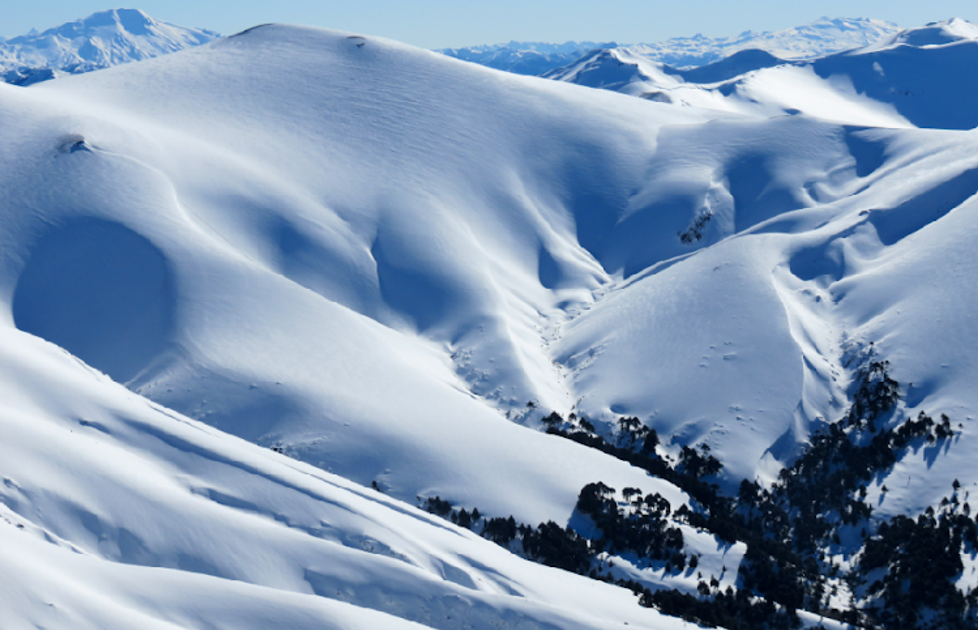
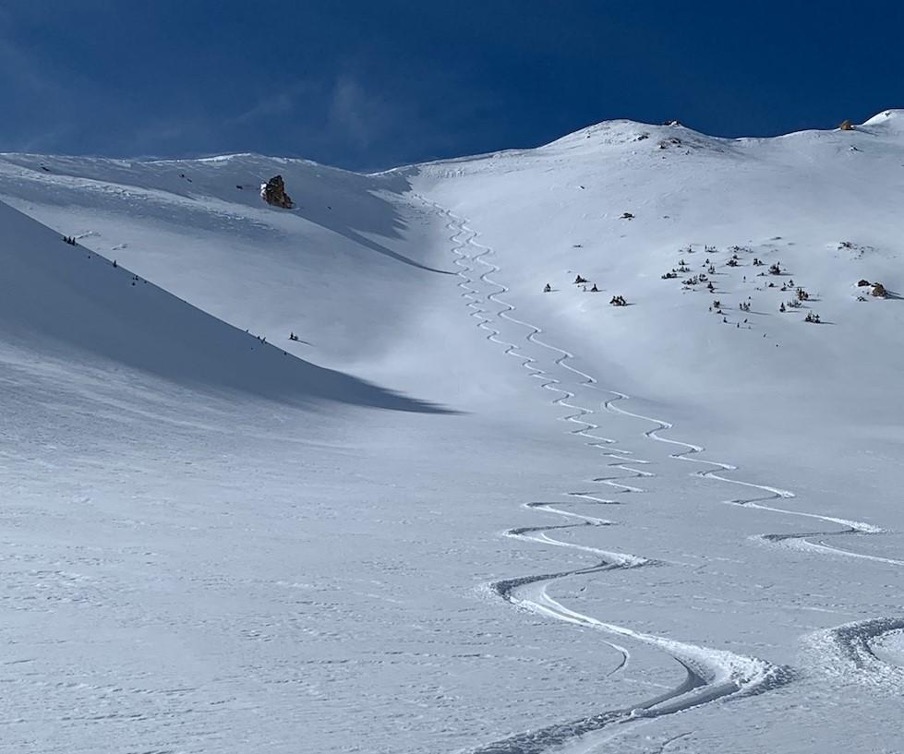
- Adopt an appropriate mindset and expectations. The biggest factor in our exposure to risk, are our decisions about where we go, and how we move through the terrain. Two of the hallmarks of a persistent slab avalanche problem are a decrease in recent avalanche activity and an absence of easily observed signs of instability. This can lead to complacency in our decision-making and lull us into a false sense of security. We can be lured into more dangerous terrain by better riding conditions or more exciting tours. What if snow conditions are marginal on slopes without the problem? Simple, flat terrain can be boring; so can going to the same places over and over because we know the terrain there is safe. The truth is, we need to adjust our expectations to the realities of the snowpack. Persistent slab avalanche problems persist, sometimes for a large portion of the season. In 28 winters as a backcountry skier and avalanche forecaster, there have been many times I have had to realign my expectations to match the conditions. Be patient and remain vigilant. Remember the nature of the problem and keep it in the front of your mind when planning your tour or deciding which slope to ski. Talk it through with your partners and set reasonable expectations for the day.
Incorporating these practices into your terrain selection and group management decisions will help you stay safer when dealing with this challenging avalanche problem. When you read the bulletin, make sure you look beyond the danger rating—know the avalanche problem and distribution. Be diligent with your tour planning and leave wide margins of safety with your terrain selection. Be aware of your position in the terrain and avoid being under or near aspects that harbor the problem. Avoid trigger points and use care when selecting your safe zones. Know the type of terrain you will be traveling in and choose simpler terrain, with lower-angled slopes that aren’t threatened by overhead hazard. Align your expectations with the conditions and stay diligent with your terrain selection and decision-making over the long haul. The persistent slab avalanche problem is an unpredictable and dangerous beast, but with careful planning and thoughtful decision-making, you can still enjoy getting out even when it is on the problem list.
Colin Mitchell has worked as an avalanche forecaster, educator, guide, and patroller for 28 seasons in the U.S., South America, and Asia. Currently he is an avalanche forecaster for the Colorado Avalanche Information Center, based out of Silverton, Colo. During the summer months he works as an avalanche educator and forecaster in South America.


